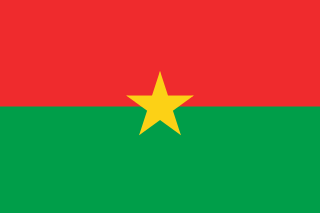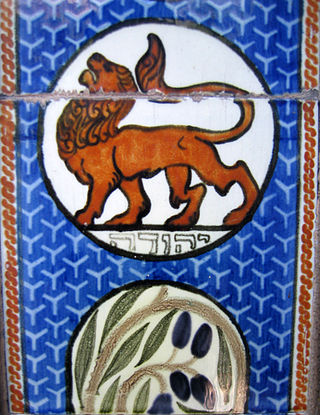
Rastafari is an Abrahamic religion that developed in Jamaica during the 1930s. It is classified as both a new religious movement and a social movement by scholars of religion. There is no central authority in control of the movement and much diversity exists among practitioners, who are known as Rastafari, Rastafarians, or Rastas.

The national flag of Burkina Faso is formed by two equal horizontal bands of red (top) and green, with a yellow five-pointed star resting in the center. The flag was adopted on 4 August 1984. The flag uses the Pan-African colours of Ethiopia, reflecting both a break with the country's colonial past and its unity with other African ex-colonies. The red is also said to symbolize the revolution and the green the abundance of agricultural and natural riches. The yellow star placed over the red and green stripes represents the guiding light of the revolution. The flag was adopted following the coup of 1983 which brought Thomas Sankara to power.

Dreadlocks, also known as dreads or locs, are a hairstyle made of rope-like strands of hair. This is done by not combing the hair and leaving it to mat naturally or by twisting it manually. Over time, the hair will form tight braids or ringlets.

Pan-African colours is a term that may refer to two different sets of colours:

The Lion of Judah is a Jewish national and cultural symbol, traditionally regarded as the symbol of the tribe of Judah. The association between the Judahites and the lion can first be found in the blessing given by Jacob to his fourth son, Judah, in the Book of Genesis of the Hebrew Bible.

Tinctures are the colours, metals, and furs used in heraldry. Nine tinctures are in common use: two metals, or and argent ; the colours gules (red), azure (blue), vert (green), sable (black), and purpure (purple); and the furs ermine, which represents the winter fur of a stoat, and vair, which represents the fur of a red squirrel. The use of other tinctures varies depending on the time period and heraldic tradition in question.

The Flag of Ethiopia consists of a green, yellow, and red tricolour with the national emblem, a golden pentagram on a blue disc, superimposed at the center. While the colors green, yellow, and red in combination held symbolic importance since at least the early 17th century, the modern tricolour was first adopted on 11 October 1897 by Menelik II, and the present flag on 31 October 1996.
Jamaican culture consists of the religion, norms, values, and lifestyle that define the people of Jamaica. The culture is mixed, with an ethnically diverse society, stemming from a history of inhabitants beginning with the original inhabitants of Jamaica. The Spaniards originally brought slavery to Jamaica. Then they were overthrown by the English. Jamaica later gained emancipation on 1 August 1838, and independence from the British on 6 August 1962. Black slaves became the dominant cultural force as they suffered and resisted the harsh conditions of forced labour. After the abolition of slavery, Chinese and Indian migrants were transported to the island as indentured workers, bringing with them ideas from their country.
Christafari is a Christian reggae band formed in 1989. It is centered on Christ Jesus and follows the personality of ordained minister Mark Mohr, an American, and born-again Christian. Until the age of 17, Mohr was a Rastafarian.
Mortimo St George "Kumi" Planno, was a renowned Rastafari elder, drummer and a follower of the back-to-Africa movement founded in the 1910s by Marcus Garvey. He is best known as the Rasta teacher and friend of Bob Marley, and as the man who commanded the respect of a chaotic crowd during the arrival of Emperor Haile Selassie on his visit to Jamaica in 1966. He is referred to by other Rastas as a teacher and a leader within the context of the faith, given his life's work.
The Twelve Tribes of Israel is a Rastafari religious group and one of the Mansions of Rastafari. Its headquarters is on Hope Road in Kingston, Jamaica. The group was formed in 1968 by Vernon Carrington, who was known to the organisation as "Prophet Gad". The twelve tribes have been described as the Rastafari mansion closest in beliefs to Christianity or Messianic Judaism. Members follow the teaching of reading the Bible a chapter a day from Genesis 1 - Revelation 22, a practice encouraged by Carrington. It is the most liberal of the Rastafarian orders and members are free to worship in a church or building of their choosing.
Ras Sam Brown was a Jamaican Rastafari elder.
Iyaric, also called Dread Talk or Rasta Talk, is a form of language constructed by members of the Rastafari movement through alteration of vocabulary. When Africans were taken into captivity as a part of the slave trade, English was imposed as a colonial language and their traditional African languages were lost. In defiance, the Rastafari movement created a modified English vocabulary and dialect, with the aim of liberating their language from its history as a tool of colonial oppression. This is accomplished by avoiding sounds and words with negative connotations, such as "back", and changing them to positive ones. Iyaric sometimes also plays a liturgical role among Rastas, in addition to Amharic and Ge'ez.

Mansions of Rastafari is an umbrella term for the various groups of the Rastafari movement. Such groups include the Bobo Ashanti, the Niyabinghi, the Twelve Tribes of Israel, and several smaller groups, including African Unity, Covenant Rastafari, Messianic Dreads, SeeGold Empire, and the Selassian Church. The term is taken from the Biblical verse in John 14:2, "In my Father's house are many mansions."
Grounation Day is the most important Rastafari holy day, It is celebrated in honour of Haile Selassie's 1966 visit to Jamaica.
The flag and coat of arms of Kedah are the state symbols of Kedah, Malaysia. Few distinctions are present between the flag and coat of arms of the state, as the flag consists of only a red field with the state arms on the upper hoist.
Color symbolism in art, literature, and anthropology is the use of color as a symbol in various cultures and in storytelling. There is great diversity in the use of colors and their associations between cultures and even within the same culture in different time periods. The same color may have very different associations within the same culture at any time. Diversity in color symbolism occurs because color meanings and symbolism occur on an individual, cultural and universal basis. Color symbolism is also context-dependent and influenced by changes over time. Symbolic representations of religious concepts or articles may include a specific color with which the concept or object is associated.
Kenyan reggae is mainly a fusion of Jamaican reggae and local ethnic singing styles that incorporate benga and Kenyan hip hop.

Jamaican Ethiopians comprise Jamaican emigrants and expatriates residing in Ethiopia.
Multicultural Toronto English (MTE) is a multi-ethnic dialect of Canadian English used in the Greater Toronto Area (GTA), particularly among young non-white working-class speakers. First studied in linguistics research of the late 2010s and early 2020s, the dialect is popularly recognized by its phonology and lexicon, commonly known as the Toronto accent and Toronto slang, respectively. It is a byproduct of the city's multiculturalism, generally associated with Millennial and Gen Z populations in ethnically diverse districts of Toronto. It is also spoken outside of the GTA, in cities such as Hamilton, Barrie, and Ottawa.









